
Are Wooden Knitting Needles Better Than Metal?
Knitting Needles are available in a number of sizes, materials, and styles, allowing knitters to create a variety of stitch sizes and knitted items. Knitting needles are normally made of wood, metal, or plastic and range in size from 0000 to 50, with straight, circular, double-pointed, and interchangeable varieties available.
While different types of needles have varied characteristics, material selection is largely a matter of personal taste. To find the best needle for you, you'll need to experiment with different types and see what you like. However, there are a few fundamental recommendations for knitting needles that are regularly utilized.
Wood
Most people begin with wooden needles, which is what we recommend for our young knitters. Wood has the advantage of being less slippery for beginner knitters, making it less frustrating to learn on. It's also a popular choice for folks who work with double-pointed needles because it's less likely that stitches would fall off the ends.
What are the drawbacks? They can be aggravating for individuals who seek quickness. For those who prefer double-pointed needles, the lesser needle sizes are unfortunately snappable.
Metal
Metal needles are more durable than wood or plastic needles, and they provide knitters with higher knitting speeds and the smoothest surfaces. Metal needles are especially effective with yarns that tend to catch, making knitting with them smoother and less irritating. When metal needles are used, they make the traditional "clicking" sound. Some people appreciate the sound of knitting needles while others despise it and seek out calmer alternatives.
Plastic and Other Materials
There are knitting needles made out of plastic, carbon fiber and even some other materials. Plastic needles are the cheapest kind of knitting needle, and they're an excellent choice for someone who wants to attempt knitting for the first time. They are the lightest and have a smoothness equivalent to hardwood needles.
The Bottom Line
The type of needle you need can often be decided by looking at the project. Certain projects have demands that can be met only by using a particular type of needles. Everyone knits differently, thus the tightness of your knitting should be considered when selecting needles. Finding the gauge is the best approach to figure out what size needle you'll need for a project. The number of stitches per inch knitted with a given yarn and needle is referred to as gauge. The gauge for the project is more significant than the needle size provided in most patterns. Knit a test swatch and count how many stitches per inch you get, then change the needle size until the gauge fits the pattern.
Questions? Get in touch with Vardhman to have all your queries answered. Email us at customercare@vardhman.com or call 81466-25292 for more information.

